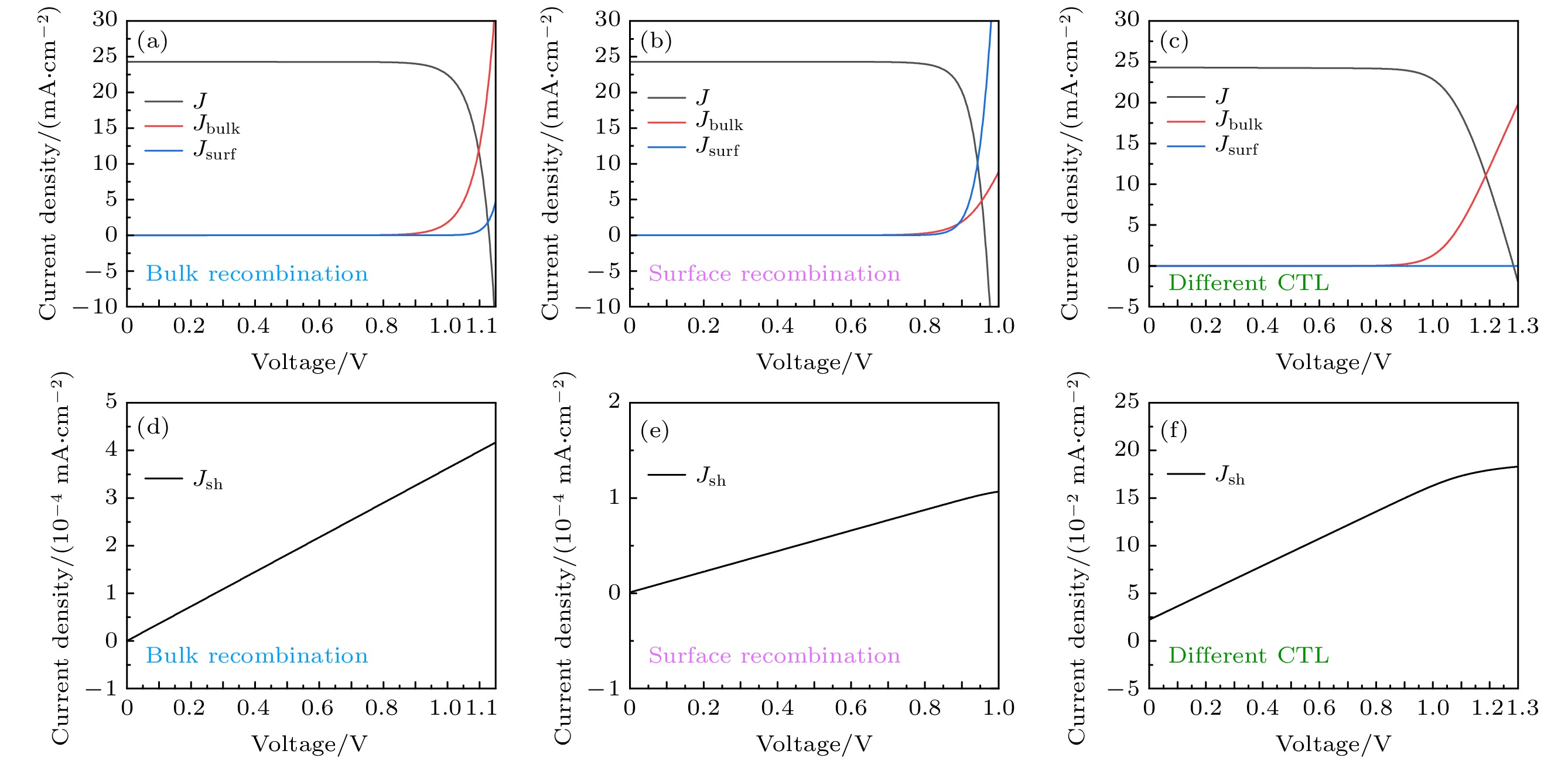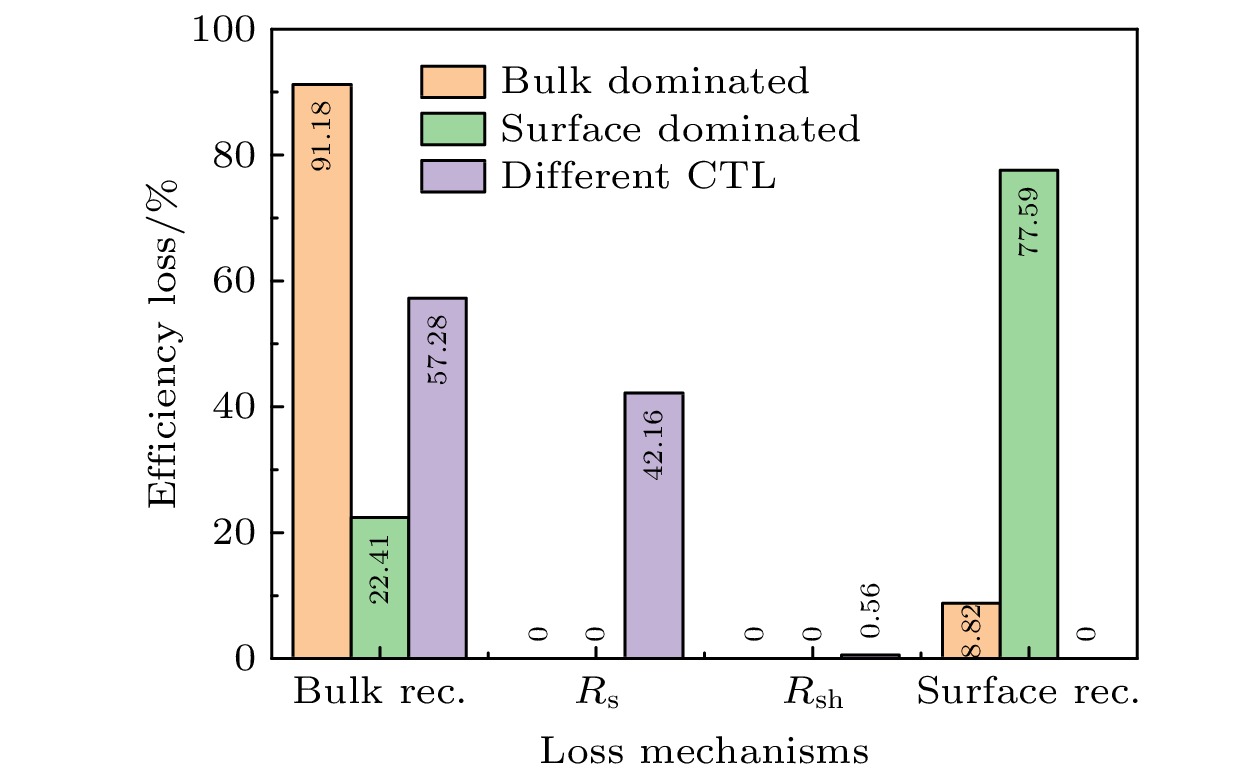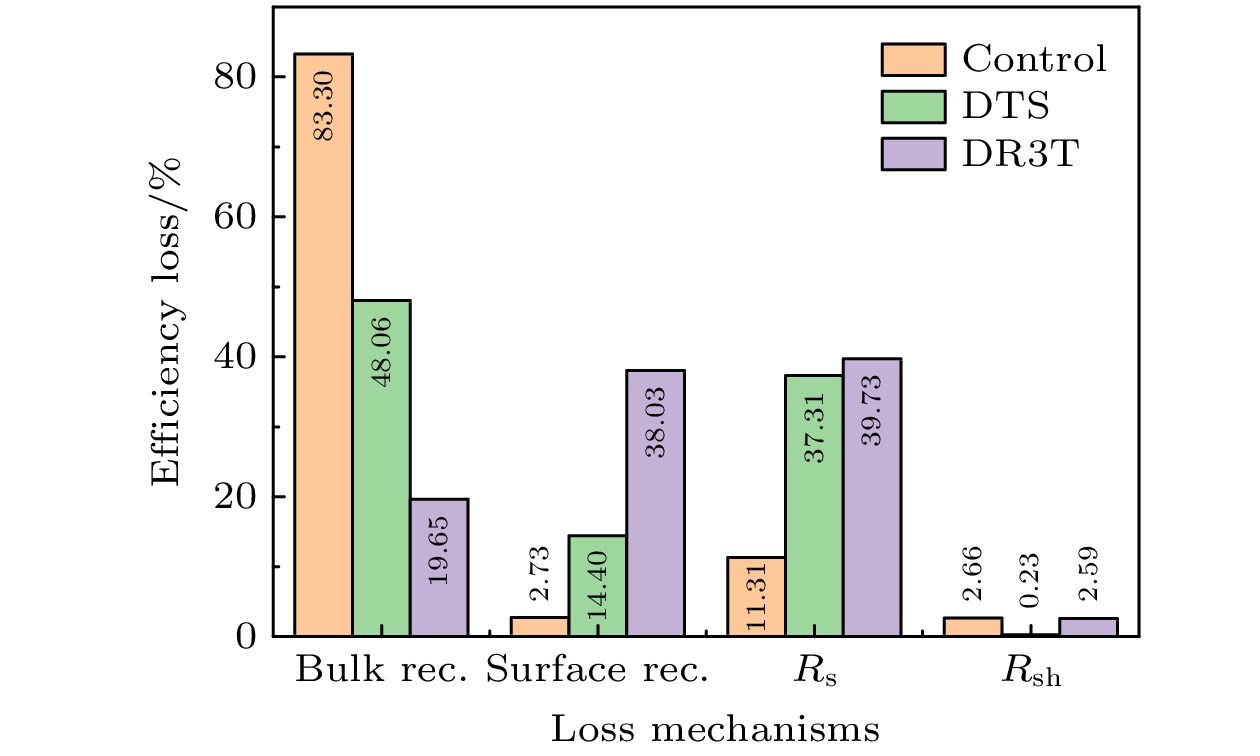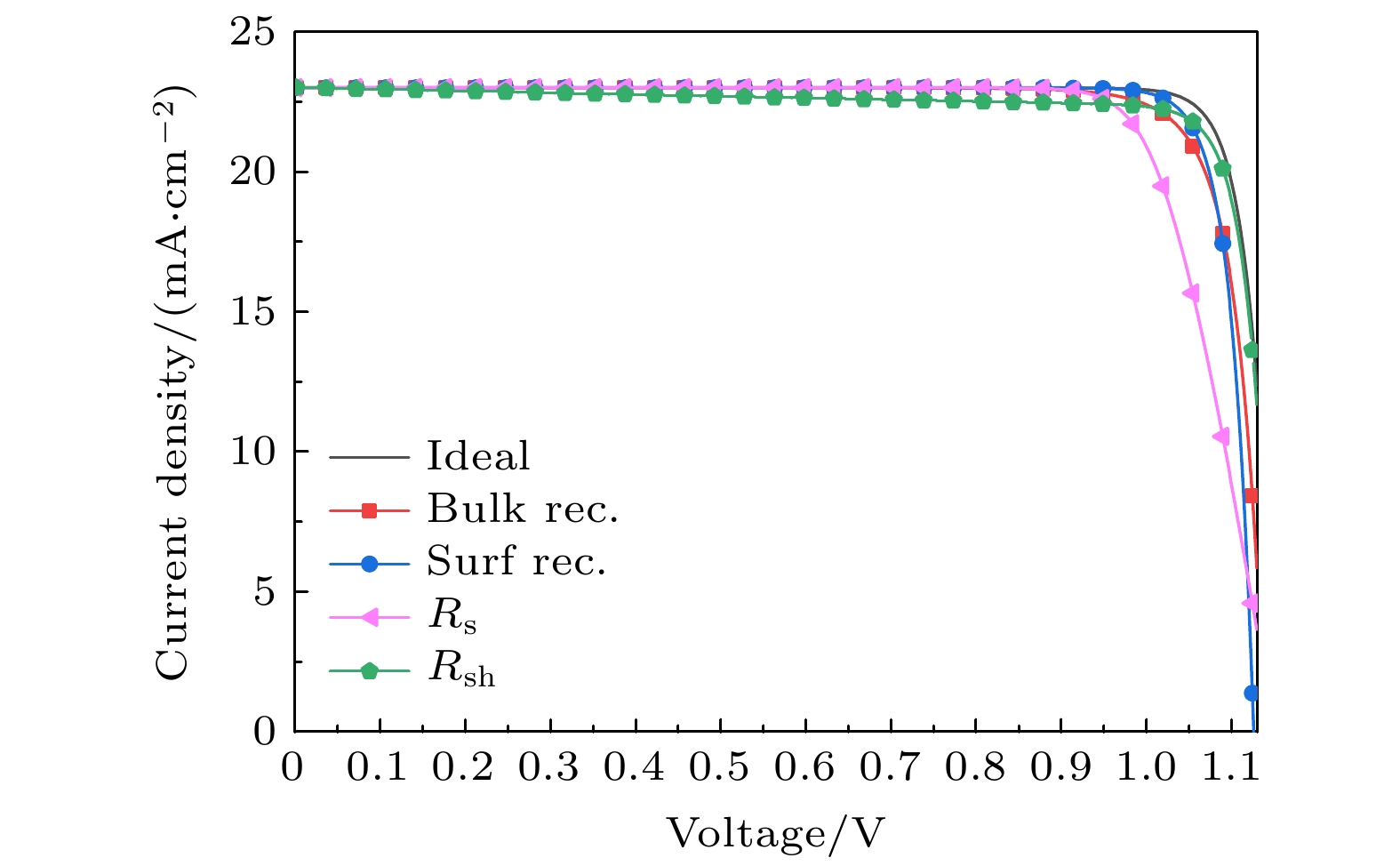-
Perovskite solar cells have been attracting more and more attentions due to their extraordinary performances in the photovoltaic field. In view of the highest certified power conversion efficiency of 25.5% that is much lower than the corresponding Shockley-Queisser limit, understanding and quantifying the main loss factors affecting the power conversion efficiency of perovskite solar cells are urgently needed. At present, the three loss mechanisms generally recognized are optical loss, ohmic loss, and non-radiative recombination loss. Including the trap-assisted bulk recombination and surface recombination, the non-radiative recombination is proved to be the dominant recombination mechanism prohibiting the increase of efficiency. In this work, based on semiconductor physics, the expressions of bulk and surface recombination currents are analytically derived. Then taking the optical loss, series and shunt resistance losses, and bulk and surface recombination losses into considerations, an equivalent circuit model is proposed to describe the current density-voltage characteristics of practical perovskite solar cells. Furthermore, by comparing to the drift-diffusion model, the pre-defined physical parameters of the drift-diffusion model well agree with the fitting parameters retrieved by the equivalent circuit model, which verifies the reliability of the proposed model. For example, the carrier lifetimes in the drift-diffusion model are consistent with the recombination factors in the equivalent circuit model. Moreover, when the circuit model is applied to analyze experimental results, the fitting outcomes show favorable consistency to the physical investigations offered by the experiments. And the relative fitting errors of the above cases are all less than 2%. Through employing the model, the dominant recombination type is clearly identified and split current density-voltage curves characterizing different loss mechanisms are offered, which intuitively reveals the physical principles of efficiency loss. Additionally, through calculating the efficiency loss ratios under the open-circuit voltage condition, quantifying the above-mentioned loss mechanisms becomes simple and compelling. The prediction capability of the model is expected to be enhanced if a series of light intensity dependent current density-voltage curves are fitted simultaneously. Consequently, this model offers a guideline to approach the efficiency limit from a circuit-level perspective. And the model is a comprehensive simulation and analysis tool for understanding the device physics of perovskite solar cells.
-
Keywords:
- perovskite solar cell /
- equivalent circuit model /
- bulk recombination /
- surface recombination
[1] Shockley W, Queisser H J 1961 J. Appl. Phys. 32 510
 Google Scholar
Google Scholar
[2] NREL Best Research-Cell Efficiencies https://www.nrel.gov/pv/cell-efficiency.html [2020-11-06]
[3] Wehrenfennig C, Eperon G E, Johnston M B, Snaith H J, Herz L M 2014 Adv. Mater. 26 1584
 Google Scholar
Google Scholar
[4] Sha W E I, Zhang H, Wang Z S, Zhu H L, Ren X, Lin F, Jen A K Y, Choy W C H 2018 Adv. Energy Mater. 8 1701586
 Google Scholar
Google Scholar
[5] Wetzelaer G A H, Scheepers M, Sempere A M, Momblona C, Ávila J, Bolink H J 2015 Adv. Mater. 27 1837
 Google Scholar
Google Scholar
[6] Johnston M B, Herz L M 2016 Acc. Chem. Res. 49 146
 Google Scholar
Google Scholar
[7] Xing G, Mathews N, Lim S S, Yantara N, Liu X, Sabba D, Grätzel M, Mhaisalkar S, Sum T C 2014 Nat. Mater. 13 476
 Google Scholar
Google Scholar
[8] Chen B, Rudd P N, Yang S, Yuan Y, Huang J 2019 Chem. Soc. Rev. 48 3842
 Google Scholar
Google Scholar
[9] Tress W, Marinova N, Inganös O, Nazeeruddin M K, Zakeeruddin S M, Graetzel M 2015 Adv. Energy Mater. 5 1400812
 Google Scholar
Google Scholar
[10] Sherkar T S, Momblona C, Gil-Escrig L, Bolink H J, Koster L J A 2017 Adv. Energy Mater. 7 1602432
 Google Scholar
Google Scholar
[11] Tvingstedt K, Deibel C 2016 Adv. Energy Mater. 6 1502230
 Google Scholar
Google Scholar
[12] Zarazua I, Han G, Boix P P, Mhaisalkar S, Fabregat-Santiago F, Mora-Seró I, Bisquert J, Garcia-Belmonte G 2016 J. Phys. Chem. Lett. 7 5105
 Google Scholar
Google Scholar
[13] Pockett A, Eperon G E, Peltola T, Snaith H J, Walker A, Peter L M, Cameron P J 2015 J. Phys. Chem. C 119 3456
 Google Scholar
Google Scholar
[14] Guerrero A, Garcia-Belmonte G, Mora-Sero I, Bisquert J, Kang Y S, Jacobsson T J, Correa-Baena J, Hagfeldt A 2016 J. Phys. Chem. C 120 8023
 Google Scholar
Google Scholar
[15] Kiermasch D, Rieder P, Tvingstedt K, Baumann A, Dyakonov V 2016 Sci. Rep. 6 39333
 Google Scholar
Google Scholar
[16] Kiermasch D, Gil-Escrig L, Baumann A, Bolink H J, Dyakonov V, Tvingstedt K 2019 J. Mater. Chem. A 7 14712
 Google Scholar
Google Scholar
[17] Wolff C M, Caprioglio P, Stolterfoht M, Neher D 2019 Adv. Mater. 31 1902762
 Google Scholar
Google Scholar
[18] van Reenen S, Kemerink M, Snaith H J 2015 J. Phys. Chem. Lett. 6 3808
 Google Scholar
Google Scholar
[19] Ren X, Wang Z, Sha W E I, Choy W C H 2017 ACS Photonics 4 934
 Google Scholar
Google Scholar
[20] Xiang J, Li Y, Huang F, Zhong D 2019 Phys. Chem. Chem. Phys. 21 17836
 Google Scholar
Google Scholar
[21] Herz L M 2017 ACS Energy Lett. 2 1539
 Google Scholar
Google Scholar
[22] Wang Z S, Ebadi F, Carlsen B, Choy W C H, Tress W 2020 Small Methods 4 2000290
 Google Scholar
Google Scholar
[23] Sendner M, Nayak P K, Egger D A, Beck S, Müller C, Epding B, Kowalsky W, Kronik L, Snaith H J, Pucci A, Lovrinčić R 2016 Mater. Horiz. 3 613
 Google Scholar
Google Scholar
[24] Richardson G, O'Kane S E J, Niemann R G, Peltola T A, Foster J M, Cameron P J, Walker A B 2016 Energy Environ. Sci. 9 1476
 Google Scholar
Google Scholar
[25] Yao J, Kirchartz T, Vezie M S, Faist M A, Gong W, He Z, Wu H, Troughton J, Watson T, Bryant D, Nelson J 2015 Phys. Rev. Appl. 4 014020
 Google Scholar
Google Scholar
[26] Braly I L, DeQuilettes D W, Pazos-Outón L M, Burke S, Ziffer M E, Ginger D S, Hillhouse H W 2018 Nat. Photonics 12 355
 Google Scholar
Google Scholar
[27] Niu T, Lu J, Munir R, Li J, Barrit D, Zhang X, Hu H, Yang Z, Amassian A, Zhao K, Liu S F 2018 Adv. Mater. 30 1706576
 Google Scholar
Google Scholar
[28] Mukherjee S, Proctor C M, Tumbleston J R, Bazan G C, Nguyen T, Ade H 2015 Adv. Mater. 27 1105
 Google Scholar
Google Scholar
[29] Zheng L L, Chung Y H, Ma Y Z, Zhang L P, Xiao L X, Chen Z J, Wang S F, Qu B, Gong Q H 2014 Chem. Commun. 50
 Google Scholar
Google Scholar
[30] Tress W 2017 Adv. Energy Mater. 7 1602358
 Google Scholar
Google Scholar
[31] Unger E L, Hoke E T, Bailie C D, Nguyen W H, Bowring A R, Heumüller T, Christoforo M G, McGehee M D 2014 Energy Environ. Sci. 7 3690
 Google Scholar
Google Scholar
[32] Calado P, Burkitt D, Yao J, Troughton J, Watson T M, Carnie M J, Telford A M, O’Regan B C, Nelson J, Barnes P R F 2019 Phys. Rev. Appl. 11 44005
 Google Scholar
Google Scholar
-
图 2 不同缺陷类型和传输层迁移率对应的钙钛矿太阳电池
$ J\text{-}V $ 曲线图 (a) 非辐射复合机制仅考虑体复合; (b) 表面复合为主导非辐射复合机制; (c) 不考虑非辐射复合且改变传输层迁移率. 其中, 红色点划线为漂移-扩散模型仿真得到的$ J\text{-}V $ 曲线, 而黑色实线为经等效电路模型拟合得到的$ J\text{-}V $ 曲线Figure 2. The J -V curves of perovskite solar cells with different non-radiative recombination types and different transport layers: (a) Only bulk recombination is considered; (b) surface recombination is the dominant non-radiative recombination mechanism; (c) without non-radiative recombination and the mobility of transport layers is changed. The red-dot lines represent
$ J\text{-}V $ curves that are simulated by drift-diffusion model, and the curves fitted by equivalent circuit model are shown in the dark solid lines.图 3 根据(1)式分解的不同情况下的钙钛矿太阳电池电流组成示意图 (a), (d) 仅考虑体复合; (b), (e) 非辐射复合以表面复合为主; (c), (f)不考虑非辐射复合但改变传输层. 其中
$ J $ 代表钙钛矿太阳电池的总电流,$J_{{\rm{bulk}}}$ 为体复合电流,$J_{{\rm{surf}}}$ 为表面复合电流,$J_{{\rm{sh}}}$ 为电阻电流Figure 3. Decompositions of the total current density of perovskite solar cells according to Eq. (1): (a), (d) Only bulk recombination is considered; (b), (e) only surface recombination is considered; (c), (f) without non-radiative recombination and with different transport layers. J represents the total current, Jbulk represents the bulk recombination current and Jsurf represents the surface recombination current.
$J_{{\rm{sh}}}$ represents the resistance current图 5 根据(1)式分解的不同情况下的钙钛矿太阳电池电流组成示意图 (a) 未进行钙钛矿层晶界修饰的钙钛矿太阳电池器件; (b) 钙钛矿层引入DTS的太阳电池器件; (c)钙钛矿层引入DR3T 的器件. 其中
$J_{{\rm{theoretical}}}$ 代表等效电路模型拟合得到的钙钛矿太阳电池的总电流,$J_{{\rm{bulk}}}$ 为其体复合电流,$J_{{\rm{surf}}}$ 为表面复合电流,$J_{{\rm{experimental}}}$ 为实验测得的电流曲线; 插图表示漏电流$J_{{\rm{sh}}}$ 随电压的变化Figure 5. Decompositions of the total current density of perovskite solar cells according to Eq. (1): (a) Devices based on the control MAPbI
$ _3 $ films; (b) devices based on the DTS passivated MAPbI$ _3 $ films; (c) devices based on the DR3T passivated MAPbI$ _3 $ films. Jtheoretical represents the total theoretical current, Jbulk represents the bulk recombination current, Jsurf represents the surface recombination current and Jexperimental represents the experimental current. The insets show the bias voltage dependence of$J_{{\rm{sh}}}$ 表 1 不同情况下钙钛矿太阳电池J -V曲线对应的特征参数表
Table 1. Parameters retrieved from the J -V curves of different cases.
Cases $\gamma_ {\rm{bulk} }/{\rm s}^{-1}$ $\gamma_ {\rm{surf} }/{\rm s}^{-1}$ Rs/$\left({{\Omega} }\cdot {\rm{cm} }^2\right)$ $R_{{\rm{sh}}}$/$\left(\Omega \cdot {\rm{cm} }^2\right)$ $J_{{\rm{sc}}}/({\rm{mA}}\cdot {\rm{cm}}^{-2})$ $V_{{\rm{oc}}}$/V $FF$/% $PCE$/% Bulk $2.07\times10^6$ $3.48\times10^{5}$ $3.34\times10^{-3}$ $1.46\times10^{6}$ $24.28$ $1.13$ $82.33$ $22.58$ Surface $1.30\times10^7$ $1.95\times10^{9}$ $3.84\times10^{-1}$ $9.24\times10^{6}$ $24.30$ $0.96$ $84.32$ $19.74$ CTL $8.75\times10^4$ $0.86$ $7.03\times10^{-1}$ $7.00\times10^{3}$ $24.32$ $1.28$ $73.15$ $22.85$ 注1: Bulk代表仅考虑体复合, Surface代表仅考虑表面复合, CTL代表不考虑非辐射复合但改变传输层迁移率的情况. $\gamma_{{\rm{bulk}}}$代表体复合系数; $\gamma_{{\rm{surf}}}$代表表面复合系数; $R_{\rm{s}}$为串联电阻; $R_{{\rm{sh}}}$为并联电阻; $J_{{\rm{sc}}}$, $V_{{\rm{oc}}}$, FF和$PCE$分别代表经计算得到的短路电流、开路电压、填充因子和光电转换效率. 表 2 不同情况下经等效电路模型和漂移-扩散模型仿真得到的非辐射复合参数表
Table 2. Nonradiative recombination parameters retrieved from different cases by equivalent circuit model and drift-diffusion model.
Cases $\tau_{ {\rm{bulk} } }/{\rm s}$ ${\tau^{-1}_{ {\rm{bulk} } } }/{\rm s}^{-1}$ $\gamma_{ {\rm{bulk} } }/{\rm s}^{-1}$ $\tau_{ {\rm{surf} } }/{\rm s}$ ${\tau^{-1}_{ {\rm{surf} } } }/{\rm s}^{-1}$ $\gamma_{{\rm{surf}}}/{\rm s}^{-1}$ Bulk $1.00\times10^{-7}$ $1.00\times10^{7}$ $2.07\times10^{6}$ ${\rm{Inf}}$ ${\rm{Inf}}\ {\rm{small}}$ $3.48\times10^{5}$ Surface ${\rm{Inf}}$ ${\rm{Inf}}\ {\rm{small}}$ $1.30\times10^{7}$ $1.00\times10^{-9}$ $1.00\times10^9$ $1.95\times10^9$ CTL ${\rm{Inf}}$ ${\rm{ Inf}}\ {\rm{small}}$ $8.75\times10^{4}$ ${\rm{Inf}}$ ${\rm{Inf}}\ {\rm{small}}$ $0.86$ 表 3 不同情况下钙钛矿太阳电池J -V曲线对应的特征参数表
Table 3. Parameters retrieved from the J -V curves of different cases.
Cases $\gamma_{{\rm{bulk}}}/{\rm s}^{-1}$ $U_{{\rm{surf}}}/({\rm {nm}} \cdot{\rm {cm}}^{3} \cdot {\rm s}^{-1})$ ${R_{\rm{s}}}$/$\left(\Omega \cdot { {\rm{cm} } }^2\right)$ $R_{{\rm{sh}}}$/$\left(\Omega \cdot { {\rm{cm} } }^2\right)$ $J_{{\rm{sc}}}$/$\left({\rm{mA}} \cdot {\rm{cm}}^{-2}\right)$ $V_{{\rm{oc}}}$/${\rm{V}}$ $FF$/% $PCE$/% Control $7.43\times10^6$ $9.65\times10^{-7}$ $2.10$ $1.73\times10^{3}$ $21.29$ $1.06$ $76.03$ $17.24$ DTS $1.89\times10^6$ $8.61\times10^{-7}$ $3.71$ $1.83\times10^{3}$ $22.50$ $1.11$ $77.16$ $19.34$ DR3T $7.17\times10^5$ $1.96\times10^{-6}$ $4.20$ $1.63\times10^{3}$ $22.95$ $1.12$ $77.05$ $19.77$ -
[1] Shockley W, Queisser H J 1961 J. Appl. Phys. 32 510
 Google Scholar
Google Scholar
[2] NREL Best Research-Cell Efficiencies https://www.nrel.gov/pv/cell-efficiency.html [2020-11-06]
[3] Wehrenfennig C, Eperon G E, Johnston M B, Snaith H J, Herz L M 2014 Adv. Mater. 26 1584
 Google Scholar
Google Scholar
[4] Sha W E I, Zhang H, Wang Z S, Zhu H L, Ren X, Lin F, Jen A K Y, Choy W C H 2018 Adv. Energy Mater. 8 1701586
 Google Scholar
Google Scholar
[5] Wetzelaer G A H, Scheepers M, Sempere A M, Momblona C, Ávila J, Bolink H J 2015 Adv. Mater. 27 1837
 Google Scholar
Google Scholar
[6] Johnston M B, Herz L M 2016 Acc. Chem. Res. 49 146
 Google Scholar
Google Scholar
[7] Xing G, Mathews N, Lim S S, Yantara N, Liu X, Sabba D, Grätzel M, Mhaisalkar S, Sum T C 2014 Nat. Mater. 13 476
 Google Scholar
Google Scholar
[8] Chen B, Rudd P N, Yang S, Yuan Y, Huang J 2019 Chem. Soc. Rev. 48 3842
 Google Scholar
Google Scholar
[9] Tress W, Marinova N, Inganös O, Nazeeruddin M K, Zakeeruddin S M, Graetzel M 2015 Adv. Energy Mater. 5 1400812
 Google Scholar
Google Scholar
[10] Sherkar T S, Momblona C, Gil-Escrig L, Bolink H J, Koster L J A 2017 Adv. Energy Mater. 7 1602432
 Google Scholar
Google Scholar
[11] Tvingstedt K, Deibel C 2016 Adv. Energy Mater. 6 1502230
 Google Scholar
Google Scholar
[12] Zarazua I, Han G, Boix P P, Mhaisalkar S, Fabregat-Santiago F, Mora-Seró I, Bisquert J, Garcia-Belmonte G 2016 J. Phys. Chem. Lett. 7 5105
 Google Scholar
Google Scholar
[13] Pockett A, Eperon G E, Peltola T, Snaith H J, Walker A, Peter L M, Cameron P J 2015 J. Phys. Chem. C 119 3456
 Google Scholar
Google Scholar
[14] Guerrero A, Garcia-Belmonte G, Mora-Sero I, Bisquert J, Kang Y S, Jacobsson T J, Correa-Baena J, Hagfeldt A 2016 J. Phys. Chem. C 120 8023
 Google Scholar
Google Scholar
[15] Kiermasch D, Rieder P, Tvingstedt K, Baumann A, Dyakonov V 2016 Sci. Rep. 6 39333
 Google Scholar
Google Scholar
[16] Kiermasch D, Gil-Escrig L, Baumann A, Bolink H J, Dyakonov V, Tvingstedt K 2019 J. Mater. Chem. A 7 14712
 Google Scholar
Google Scholar
[17] Wolff C M, Caprioglio P, Stolterfoht M, Neher D 2019 Adv. Mater. 31 1902762
 Google Scholar
Google Scholar
[18] van Reenen S, Kemerink M, Snaith H J 2015 J. Phys. Chem. Lett. 6 3808
 Google Scholar
Google Scholar
[19] Ren X, Wang Z, Sha W E I, Choy W C H 2017 ACS Photonics 4 934
 Google Scholar
Google Scholar
[20] Xiang J, Li Y, Huang F, Zhong D 2019 Phys. Chem. Chem. Phys. 21 17836
 Google Scholar
Google Scholar
[21] Herz L M 2017 ACS Energy Lett. 2 1539
 Google Scholar
Google Scholar
[22] Wang Z S, Ebadi F, Carlsen B, Choy W C H, Tress W 2020 Small Methods 4 2000290
 Google Scholar
Google Scholar
[23] Sendner M, Nayak P K, Egger D A, Beck S, Müller C, Epding B, Kowalsky W, Kronik L, Snaith H J, Pucci A, Lovrinčić R 2016 Mater. Horiz. 3 613
 Google Scholar
Google Scholar
[24] Richardson G, O'Kane S E J, Niemann R G, Peltola T A, Foster J M, Cameron P J, Walker A B 2016 Energy Environ. Sci. 9 1476
 Google Scholar
Google Scholar
[25] Yao J, Kirchartz T, Vezie M S, Faist M A, Gong W, He Z, Wu H, Troughton J, Watson T, Bryant D, Nelson J 2015 Phys. Rev. Appl. 4 014020
 Google Scholar
Google Scholar
[26] Braly I L, DeQuilettes D W, Pazos-Outón L M, Burke S, Ziffer M E, Ginger D S, Hillhouse H W 2018 Nat. Photonics 12 355
 Google Scholar
Google Scholar
[27] Niu T, Lu J, Munir R, Li J, Barrit D, Zhang X, Hu H, Yang Z, Amassian A, Zhao K, Liu S F 2018 Adv. Mater. 30 1706576
 Google Scholar
Google Scholar
[28] Mukherjee S, Proctor C M, Tumbleston J R, Bazan G C, Nguyen T, Ade H 2015 Adv. Mater. 27 1105
 Google Scholar
Google Scholar
[29] Zheng L L, Chung Y H, Ma Y Z, Zhang L P, Xiao L X, Chen Z J, Wang S F, Qu B, Gong Q H 2014 Chem. Commun. 50
 Google Scholar
Google Scholar
[30] Tress W 2017 Adv. Energy Mater. 7 1602358
 Google Scholar
Google Scholar
[31] Unger E L, Hoke E T, Bailie C D, Nguyen W H, Bowring A R, Heumüller T, Christoforo M G, McGehee M D 2014 Energy Environ. Sci. 7 3690
 Google Scholar
Google Scholar
[32] Calado P, Burkitt D, Yao J, Troughton J, Watson T M, Carnie M J, Telford A M, O’Regan B C, Nelson J, Barnes P R F 2019 Phys. Rev. Appl. 11 44005
 Google Scholar
Google Scholar
Catalog
Metrics
- Abstract views: 8591
- PDF Downloads: 543
- Cited By: 0















 DownLoad:
DownLoad:
























